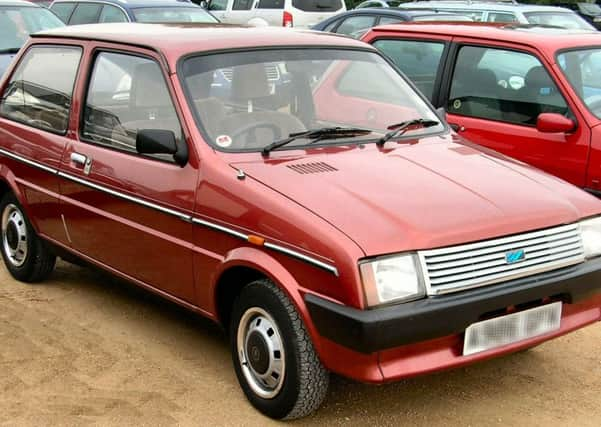Talking Motors: Mixed messages from save classic campaign


Tucked away, just enough to make anyone driving think the space was available, was a Metro. It was a horrible shade of blue - like a ball of bubblegum at the bottom of a screwball. It had rust in all the right places. The black plastic had gone a sun-bleached, sad grey. It was missing a hubcap.
It was very nearly perfect. There were just two things wrong with it.
Advertisement
Hide AdAdvertisement
Hide AdOne: It was a later Rover and not an Austin. Two: It doesn’t belong to me.
Such sights on our roads are a rarity now. More than 2,000,000 Metros were built between 1980 and 1997 - and for a variety of reasons, now just a few hundred are left on the roads. And despite wanting to go out and save one in the same way some people feel when looking at pictures of abandoned puppies on Facebook, it’s quite easy to see why they have all but vanished.
They are the dictionary’s definition of uncool; vessels to carry grandmothers to bingo, or students to college, they were hardly the trendiest cars in the world. Many ended-up full of stickers, suffered burns in seats from the cigarettes new drivers thought their parents didn’t know about and were basically run into the ground.
The Mini they were designed to replace outlived the Metro by three years.
Advertisement
Hide AdAdvertisement
Hide AdOther cars now either extinct or living on flat tyres under pensioners’ Christmas decorations include the Ford Cortina, Vauxhall Victor and Austin Allegro.
Considering how they once ruled the roads, it would be hard for people from a certain generation to believe you’d have a hard time finding enough brown plastic now if you wanted to restore one.
Happily, I read this week that I’m not alone in this unexplainable penchant for rubbish cars. A campaign is being set-up by classic car insurer ClassicLine called ‘Save our Classics’ - which is calling for a number of initiatives to keep a few more of these endangered reminders of journeys to school on the road.
The campaign wants to see the reduction of current UK road tax exemption drop from cars aged 40 and older to 30.
Advertisement
Hide AdAdvertisement
Hide AdAnd it also wants to see MOT exemption moved from cars made before 1960 to 1970.
But that’s an oversight in my view. Scrubbing vehicle tax for classics - great - it might make the difference between running the car and putting it on SORN over winter. But MOTs are different. I get that they cost money - but the idea of exempting older cars from the MOT to help make running cars affordable is dangerous and silly.
There’s a school of thought that owners of older cars look after them and know what they are doing. But if a car passes an MOT first time, what’s the cost? £40?
That’s pretty affordable if it’s once a year - so the expensive part of an MOT test is when work needs to be done because the car shouldn’t be on the road anyway. So if owners of classics were being responsible and making sure their cars were safe - this would be an expense they would incur regardless of a mandatory test.
Advertisement
Hide AdAdvertisement
Hide AdAnd if there’s no need for a test? I’m afraid human nature would take over and ‘odd jobs’ would get put off.
While the preservation of cars and memories is a vitally important part of our history, drivers need to take custodianship of classics for the right reasons - and the lack of a need to MOT a car should not be one. Classic drivers need to be more aware of safety than most other road users.
When classics are involved in accidents, the accompanying comments to the story in the press is dominated by readers slating classic car safety - it’s hard enough without the lack of an MOT.
The campaign has other good points though.
Looking at more flexible car insurance to help under-25s get insured on a classic would help usher in a new generation of enthusiasts, as would petitioning the Government to encourage schools and colleges to promote courses in classic vehicle restoration.
Advertisement
Hide AdAdvertisement
Hide AdFor more information about the campaign visit: /www.classiclineinsurance.co.uk/save-our-classics/.
Always one to bang the drum for driving and not hiding our classics, I have to admit the Midget has been used sparingly lately.
There’s a list of things to do, but it’s hard to even muster the enthusiasm even to wash and polish the car while the weather has been this wet.
Wanting to make sure I drive it as much as possible, the final straw came during a day of particularly persistent rain and what looked like a puddle in the middle of the road had me up to me knees in water.
Advertisement
Hide AdAdvertisement
Hide AdIt was an odd sensation to have the heaters blowing full blast in June, but that tactic didn’t even make a dent in the squelch of carpets going on with every depression of the clutch.
The argument for a winter car, then, has once again reared its head - despite the fact schools haven’t even broken up for their summer break yet.
Apparently an all-weather, practical car doesn’t simply mean it has a roof - and doesn’t include the following models I have helpfully suggested during teatime conversation: Ford Anglia, Morris Minor, Austin Cambridge, Triumph Vitesse.
For this reason I’ve kept the Mini card under my sleeve.
So while it is important to make sure we drive our classics as much as possible - sometimes - in the interests of dry trousers and preservation - it’s better to leave it in the garage.
Even in July.